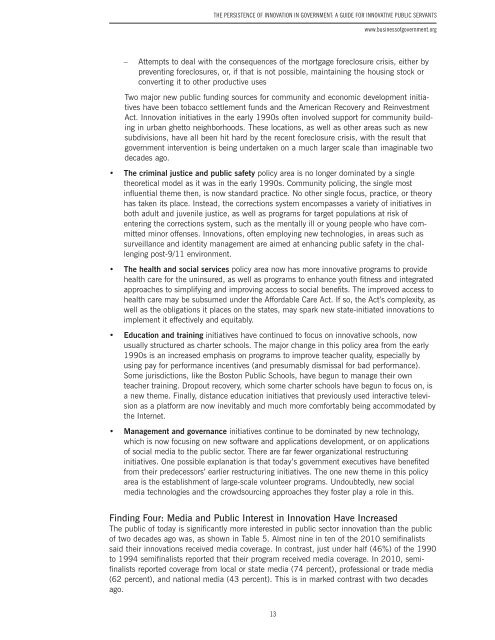The Persistence of Innovation in Government
The Persistence of Innovation in Government
The Persistence of Innovation in Government
- No tags were found...
Create successful ePaper yourself
Turn your PDF publications into a flip-book with our unique Google optimized e-Paper software.
<strong>The</strong> <strong>Persistence</strong> <strong>of</strong> <strong>Innovation</strong> <strong>in</strong> <strong>Government</strong>: A Guide for Innovative Public Servantswww.bus<strong>in</strong>ess<strong>of</strong>government.org––Attempts to deal with the consequences <strong>of</strong> the mortgage foreclosure crisis, either byprevent<strong>in</strong>g foreclosures, or, if that is not possible, ma<strong>in</strong>ta<strong>in</strong><strong>in</strong>g the hous<strong>in</strong>g stock orconvert<strong>in</strong>g it to other productive usesTwo major new public fund<strong>in</strong>g sources for community and economic development <strong>in</strong>itiativeshave been tobacco settlement funds and the American Recovery and Re<strong>in</strong>vestmentAct. <strong>Innovation</strong> <strong>in</strong>itiatives <strong>in</strong> the early 1990s <strong>of</strong>ten <strong>in</strong>volved support for community build<strong>in</strong>g<strong>in</strong> urban ghetto neighborhoods. <strong>The</strong>se locations, as well as other areas such as newsubdivisions, have all been hit hard by the recent foreclosure crisis, with the result thatgovernment <strong>in</strong>tervention is be<strong>in</strong>g undertaken on a much larger scale than imag<strong>in</strong>able twodecades ago.• <strong>The</strong> crim<strong>in</strong>al justice and public safety policy area is no longer dom<strong>in</strong>ated by a s<strong>in</strong>gletheoretical model as it was <strong>in</strong> the early 1990s. Community polic<strong>in</strong>g, the s<strong>in</strong>gle most<strong>in</strong>fluential theme then, is now standard practice. No other s<strong>in</strong>gle focus, practice, or theoryhas taken its place. Instead, the corrections system encompasses a variety <strong>of</strong> <strong>in</strong>itiatives <strong>in</strong>both adult and juvenile justice, as well as programs for target populations at risk <strong>of</strong>enter<strong>in</strong>g the corrections system, such as the mentally ill or young people who have committedm<strong>in</strong>or <strong>of</strong>fenses. <strong>Innovation</strong>s, <strong>of</strong>ten employ<strong>in</strong>g new technologies, <strong>in</strong> areas such assurveillance and identity management are aimed at enhanc<strong>in</strong>g public safety <strong>in</strong> the challeng<strong>in</strong>gpost-9/11 environment.• <strong>The</strong> health and social services policy area now has more <strong>in</strong>novative programs to providehealth care for the un<strong>in</strong>sured, as well as programs to enhance youth fitness and <strong>in</strong>tegratedapproaches to simplify<strong>in</strong>g and improv<strong>in</strong>g access to social benefits. <strong>The</strong> improved access tohealth care may be subsumed under the Affordable Care Act. If so, the Act’s complexity, aswell as the obligations it places on the states, may spark new state-<strong>in</strong>itiated <strong>in</strong>novations toimplement it effectively and equitably.• Education and tra<strong>in</strong><strong>in</strong>g <strong>in</strong>itiatives have cont<strong>in</strong>ued to focus on <strong>in</strong>novative schools, nowusually structured as charter schools. <strong>The</strong> major change <strong>in</strong> this policy area from the early1990s is an <strong>in</strong>creased emphasis on programs to improve teacher quality, especially byus<strong>in</strong>g pay for performance <strong>in</strong>centives (and presumably dismissal for bad performance).Some jurisdictions, like the Boston Public Schools, have begun to manage their ownteacher tra<strong>in</strong><strong>in</strong>g. Dropout recovery, which some charter schools have begun to focus on, isa new theme. F<strong>in</strong>ally, distance education <strong>in</strong>itiatives that previously used <strong>in</strong>teractive televisionas a platform are now <strong>in</strong>evitably and much more comfortably be<strong>in</strong>g accommodated bythe Internet.• Management and governance <strong>in</strong>itiatives cont<strong>in</strong>ue to be dom<strong>in</strong>ated by new technology,which is now focus<strong>in</strong>g on new s<strong>of</strong>tware and applications development, or on applications<strong>of</strong> social media to the public sector. <strong>The</strong>re are far fewer organizational restructur<strong>in</strong>g<strong>in</strong>itiatives. One possible explanation is that today’s government executives have benefitedfrom their predecessors’ earlier restructur<strong>in</strong>g <strong>in</strong>itiatives. <strong>The</strong> one new theme <strong>in</strong> this policyarea is the establishment <strong>of</strong> large-scale volunteer programs. Undoubtedly, new socialmedia technologies and the crowdsourc<strong>in</strong>g approaches they foster play a role <strong>in</strong> this.F<strong>in</strong>d<strong>in</strong>g Four: Media and Public Interest <strong>in</strong> <strong>Innovation</strong> Have Increased<strong>The</strong> public <strong>of</strong> today is significantly more <strong>in</strong>terested <strong>in</strong> public sector <strong>in</strong>novation than the public<strong>of</strong> two decades ago was, as shown <strong>in</strong> Table 5. Almost n<strong>in</strong>e <strong>in</strong> ten <strong>of</strong> the 2010 semif<strong>in</strong>alistssaid their <strong>in</strong>novations received media coverage. In contrast, just under half (46%) <strong>of</strong> the 1990to 1994 semif<strong>in</strong>alists reported that their program received media coverage. In 2010, semif<strong>in</strong>alistsreported coverage from local or state media (74 percent), pr<strong>of</strong>essional or trade media(62 percent), and national media (43 percent). This is <strong>in</strong> marked contrast with two decadesago.13


